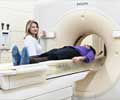Most of those with normal computed tomography (CT) scans do not require hospitalization for further observation, a large, national multi-center study has found.

The study was conducted under the auspices of the groundbreaking Pediatric Emergency Care Applied Research Network (PECARN). It is published online today in the Annals of Emergency Medicine.
"We now have definitive evidence supporting discharging most neurologically normal children with head trauma after negative CT scans home from the Emergency Department," said James Homes, professor of emergency medicine in the UC Davis School of Medicine and the study's lead author and co-investigator.
"Sending these patients home with their parents not only provides good, safe care but it also saves costs. It is a win for everyone concerned."
While blunt head trauma is the leading cause of death in children older than 1 year old, the authors said the finding shows that children with minor blunt head trauma with normal CT scans are at very low risk for subsequent traumatic findings on neuroimaging. More importantly, they are at extremely low risk of needing neurosurgical intervention.
Nevertheless, children fitting this profile frequently are admitted to hospitals for additional observation following normal CT scans. The study authors conclude that "hospitalization of children with minor head trauma after normal CT scan results for neurologic observation is generally unnecessary."
Advertisement
"Admitting these children after normal CT scans is costly, causes them to spend time away from their families and loved ones, and potentially exposes them to other health risks, such as hospital-borne infections," Kuppermann said.
Advertisement
Children often are admitted to the hospital for additional observation after blunt head trauma to allow frequent neurologic examinations. However, studies in adults have found that neurological problems following minor blunt head trauma are rare and that hospitalization after a normal cranial CT scan is unnecessary.
Enrolled in the study were 13,543 children 18 years old or younger with minor blunt head trauma who were treated in 25 emergency departments across the United States from June 2004 to September 2006. The patients' median age was about 9 years old; 63 percent were boys. The study included both children with "isolated head trauma" and head trauma and other injuries.
For the study, the authors obtained initial CT results for each patient. Study participants were considered to have normal CT scans if their radiological scans did not reveal intracranial hemorrhage, cerebral concussion, cerebral edema, or skull fractures. Those who were discharged from the emergency department received follow-up telephone calls at least one week after their emergency department visit, to determine whether their child received additional CT or MRI scans. Their families also were asked about neurologic complications, including neurosurgical interventions. Nearly 80 percent of the study participants were reached for follow-up either by telephone or mail. Those who were hospitalized were followed during their hospitalization for any deterioration.
Hundreds of the patients who were either hospitalized or discharged were found to have received repeated neuroimaging — either CT scans or MRIs or both —but none of the patients required neurosurgical intervention, indicating that there is a very low risk for patients to deteriorate after an initially normal cranial CT scan.
The authors said that the children involved in the study may have required hospitalization for injuries that were not confined to the head, and some also may have been vomiting and so admitted for intravenous fluid administration. But of the patients hospitalized, more than half only had blunt head trauma and no other injuries or ailments, and most were likely hospitalized simply for neurologic observation.
Source-Eurekalert










